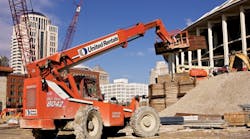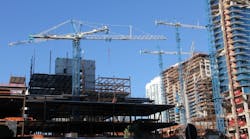Forty-two states added construction jobs between May 2016 and May 2017 amid growing demand for construction services, while 25 states and the District of Columbia lost construction jobs between April and May as firms struggle to find enough workers, according to an analysis by the Associated General Contractors of America of Labor Department data released today. Association officials said workforce shortages appear to be impacting construction employment in parts of the country.
"There is still plenty of private-sector demand for construction projects, so it is likely that some states with monthly employment declines have a shortage of workers rather than a slowdown in work," said Ken Simonson, chief economist for the association. "Given the low unemployment rate in most states, it is hard for contractors to find new construction workers, let alone experienced ones."
California added the most construction jobs (38,900 jobs, 5.0 percent) during the past year. Other states adding a high number of new construction jobs for the past 12 months include Florida (31,000 jobs, 6.6 percent); Louisiana (12,600 jobs, 9.1 percent); Washington (10,700 jobs, 5.8 percent); Texas (10,600 jobs, 1.5 percent) and Oregon (9,800 jobs, 10.9 percent). Rhode Island added the highest percentage of new construction jobs during the past year (12.8 percent, 2,300 jobs), followed by Oregon; Nevada (10.9 percent, 8,100 jobs); New Hampshire (9.5 percent, 2,400 jobs) and Louisiana.
Eight states and the District of Columbia shed construction jobs between May 2016 and May 2017. Missouri lost the largest number of construction jobs (-4,100 jobs, -3.4 percent), followed by Mississippi (-2,200 jobs, -5.1 percent) and Illinois (-1,700 jobs, -0.8 percent). The District of Columbia lost the highest percentage for the year (-7.6 percent, -1,200 jobs), followed by Alaska (-5.5 percent, -900 jobs) and Mississippi.
Pennsylvania lost more construction jobs between April and May than any other state (-4,300 jobs, -1.8 percent), followed by Missouri (-3,900 jobs, -3.3 percent) and Minnesota (-2,600 jobs, -2.1 percent). Wyoming lost the highest percentage of construction jobs for the month (-5.1 percent, -1,100 jobs), followed by South Dakota (-4.0 percent, -1,000 jobs) and Missouri. Construction employment was unchanged between April and May in Alaska, Montana and Oklahoma.
Of the 22 states that added construction jobs between April and May, Louisiana had the largest numerical and percentage increases (5,000 jobs, 3.4 percent), followed by Maryland (4,800 jobs, 3.0 percent). Alabama ranked third in percentage gain (2.9 percent, 2,500 jobs), followed by Illinois (1.9 percent, 4,000 jobs), South Carolina (1.9 percent, 1,800 jobs) and North Carolina (1.7 percent, 3,300 jobs). Illinois was third in number of jobs added for the month, followed by Texas (3,400 jobs, 0.5 percent) and North Carolina.
Association officials said Washington officials can help address growing labor shortages in the construction industry by putting in place measures that expand training opportunities for students and young adults. This includes expanding investments in secondary career and technical education, making it easier to establish apprenticeship training programs in all market types and allowing for more charter schools and career academies that focus on construction skills.
"Having the President talk about the need for more craft workers in fields like construction is helpful," Stephen Sandherr, CEO officer for the association, said. "Now it is time to act on those good intentions by putting in place measures to expand training opportunities for people considering careers in construction."










